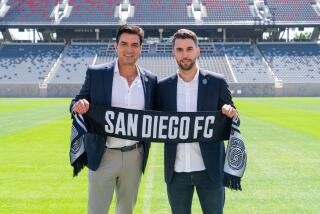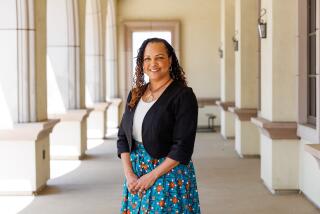Fears Eased as SDSU North County Plans Win Agency Backing
- Share via
SAN MARCOS — It didn’t take long for panic to strike.
Only days after a state education official declared in November that enrollment projections for the San Diego State University campus planned for San Marcos were absurdly high, supporters of the project from Del Mar to Fallbrook became seized with fright.
What did this mean? Could the new, far lower enrollment predictions favored by the state official doom North County’s hopes of establishing a four-year college campus? Would the region instead be awarded an unimpressive upper-division center that is little better than the existing SDSU satellite housed in rented space next to a furniture warehouse?
The prospects were disturbing.
So, determined to thwart those who would attempt to rob North County of its future as a higher education mecca, campus backers last month launched a campaign to convince state authorities reviewing the proposal that the area deserves a full-scale, four-year college.
“Our fear is that these lower enrollment numbers will lead (state officials) to believe the demand for a campus is less than it truly is,” said San Marcos City Manager Rick Gittings. “If that’s the case, then they may not buy enough land and they might not plan for a four-year campus.”
Sen. William Craven (R-Oceanside), a longtime campus advocate, agreed. In a letter to local city officials and chamber of commerce directors, Craven urged supporters to shower the California Postsecondary Education Commission (CPEC) with letters demonstrating “the demand and necessity for a full, four-year branch” of SDSU in North County.
“It’s imperative we show the urgency here, that we get them moving toward the four-year campus concept right away,” Craven said.
Officials with CPEC, which advises the state Legislature on the need for new higher education facilities and is reviewing the North County campus plan, say the local concerns are unfounded.
While CPEC’s projections for initial enrollment at the North County center are, indeed, lower than figures tallied by consultants and California State University officials, commission representatives say the disparity will have little bearing on what sort of facility takes shape here after opening in 1992.
Indeed, at a meeting today in San Francisco, a CPEC report that is highly supportive of the campus and acknowledges the phenomenal growth in North County will be presented to CPEC commissioners. The report recommends the purchase of up to 400 acres of land in San Marcos for a permanent SDSU center and predicts the facility will expand to a four-year university program around the turn of the century or sometime thereafter.
CPEC will review the report and forward comments to the governor, who then will decide whether to include money for purchase of the San Marcos parcel in his budget for next year.
“The (enrollment) numbers they provided us were unwarranted and way off, but the practical effect of our disagreement on the issue is zero,” said William Storey, the CPEC official who prepared the report forecasting a much lower student enrollment than that predicted earlier by state university administrators.
“I think there’s a certain mystique about having a campus rather than a center, which sounds sort of low class. But the bottom line is, we’ve recommended that a site be purchased and a permanent facility be constructed.”
And expansion of the facility, planned for the former Prohoroff Poultry Farms near California 78, is simply a function of the demand. “If students are beating down the door to get in, then, of course, the campus will grow,” Storey said.
SDSU President Thomas Day echoed Storey’s statement and said that “whether we start with 2,000 students or 4,000 students, you’ve still got to have things like a library, faculty offices and ancillary operations, those basic campus components.”
“It may not be as big as quickly as some people want it to be, but once we get the center established as a permanent facility, we’ll be on the road to something of a larger scale if demand merits it,” Day said.
If anything hinders the maturation of the North County center into a four-year school, it will not be CPEC but a lack of money for campus construction, Day said. Although $19 million toward purchase of the San Marcos site will come from $400 million in bond money provided by the passage of Proposition 56 last month, future funding sources for higher education have yet to be identified.
“That is something the people of North County should really be thinking about,” Day said. “It wouldn’t do us much good if we bought that lovely site and then were forced to just leave it sitting there, empty.”
The disagreement over enrollment projections for the campus concerns three conflicting sets of numbers--from Tadlock & Associates, a Carmel consulting firm hired by California State University officials to assess the need for a North County campus; a study by the office of the Chancellor of the California State University system; and Storey’s report.
Storey’s analysis pegs beginning North County enrollment at about 1,400 so-called full-time-equivalent students--or FTEs. (An FTE is a budgetary term for one student or combination of students enrolled in 15 semester units. Usually, the number of actual pupils is roughly twice the number of FTEs.)
The state university’s estimate for the initial student population is more than twice Storey’s estimate--approximately 4,000 FTEs--and Tadlock envisions an even higher number.
Storey maintains that both the Tadlock and state university predictions are “radically high.” One factor that accounts for the discrepancy in figures is the chancellor’s office assumption that 40% of those attending the North County campus will come from outside of the immediate area.
“That (40%) may be an accurate number for the main SDSU campus but it’s just not realistic for the San Marcos center,” Storey said, “It’s not going to have the immediate reputation and draw that the downtown San Diego campus has.”
In addition, Storey said the university’s projections are higher because they assume the average student will take a course load of 11 units--the same as those pupils enrolled at the main campus. Storey used 7.5 units as the typical course load in his analysis.
“We are not duplicating SDSU, not by a long shot,” Storey said, explaining why the average student at the new center will be taking fewer units. “San Marcos hasn’t got a football team, it hasn’t got dorms, it hasn’t got lower division classes. Many students will be working and just taking night classes. It’s a very different situation.”
Overall, Storey said, the data submitted by CSU was inadequate and faulty and failed to support the enrollment projections. Moreover, he said, officials failed to submit an academic master plan along with their proposal, stating simply that the curricula offered at the existing center would be available at the new school.
“That’s just not good enough,” Storey said. “This is the largest and most comprehensive off-campus center ever proposed. They should have been more diligent.”
Local campus backers say that CPEC’s supportive report and recommendation for purchase of the San Marcos site near California 78 have allayed their fears for the future--to a certain degree. Still, many seem to believe that Storey is unaware of the booming pace of growth in North County and assert that his projections are too low.
“From my standpoint, you could get 10,000 students on a North County campus tomorrow if you had the faculty and physical plant in place,” said Steve Bieri, a partner in Bieri-Avis, the Sorrento Valley development firm that owns the proposed campus site. “I just want to make sure the enrollment isn’t artificially capped because some people do their math differently than others.”
Bieri said the growth of the campus is key not only to his interests but to the City of San Marcos. The construction of major roads and development compatible with the university are planned for the area surrounding the site, and now Bieri wonders when such projects will come on line.
“How long will we be holding the land around the university, waiting for it to evolve?” Bieri said. “If it’s a small institution, how much faculty housing, commercial development and R&D; industrial (building) will be necessary? We’re just wondering how--and when--the thing is going to shape up.”
Craven said he empathizes with the impatience shared by many who have waited long years to see a campus take shape in North County. He, too, has waited.
“It’s frustrating, because it’s a slow process and we’d all love to see a four-year institution from the outset,” said Craven, the project’s chief legislative sponsor. “But I believe that once we get our toe in the door, it’s only a matter of time before our whole foot slides through.”
Efforts to construct a North County campus have been under way for almost two decades. In 1968, Craven introduced legislation that would have created a branch campus, but the effort failed. A decade later, the senator helped secure a small state grant that enabled the existing SDSU center to open.
Enrollment at that facility, located in a San Marcos industrial park, has increased steadily. This semester, 967 students attend classes there, compared to 639 students during fall of 1985.
More to Read
Sign up for Essential California
The most important California stories and recommendations in your inbox every morning.
You may occasionally receive promotional content from the Los Angeles Times.













